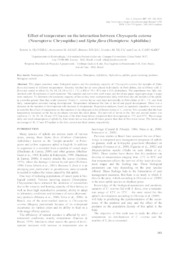Effect of temperature on the interaction between Chrysoperla externa (Neuroptera: Chrysopidae) and Sipha flava (Hemiptera: Aphididae).
Effect of temperature on the interaction between Chrysoperla externa (Neuroptera: Chrysopidae) and Sipha flava (Hemiptera: Aphididae).
Author(s): OLIVEIRA, S. A. de; AUAD, A. M.; SOUZA, B.; SILVA, D. M. da; CARVALHO, C. A. de
Summary: This paper examines some biological aspects and the predatory capacity of Chrysoperla externa fed nymphs of Sipha flava and reared at different temperatures. Recently hatched larvae were placed individually in Petri dishes, fed ad libitum with S. flava and reared at either 12, 16, 20, 24, 28 or 32 ± 1°C, a RH of 70 ± 10% and a 12-h photophase. The experiment was fully randomized with 30 replicates of each treatment. The duration and survival in each instar, and larval and pupal stages (pre-pupa + pupa) were analyzed. To determine the predatory capacity of larvae they were each provided daily with three-day-old nymphs of the aphid, in a number greater than they could consume. Ninety C. externa larvae were kept individually in Petri dishes at 24 ± 1°C, and their daily consumption recorded during development. Temperature influenced the rate of larval and pupal development. There was a decrease in the duration of development with increase in temperature. Regression analyses, based on quadratic equations, were used to describe the effect of temperature on the duration of development in the different instars of C. externa. This revealed that the base temperature increased as the larvae developed towards the adult phase. The survival of larvae in the first and second instars was similar at 12, 16, 20, 24, 28 and 32°C but none of the third instar larvae completed their development at 12°C and 32°C. The average daily and total consumption of aphids by third instar larvae was about 48 times greater than that of first instar larvae. The larvae ate an average of 10, 37 and 479 aphids in the first, second and third instars, respectively.
Publication year: 2010
Types of publication: Journal article
Unit: Embrapa Dairy Cattle
Keywords: Aphids, Green lacewing, Neuroptera, Predator, biological control
Observation
Some of Embrapa's publications are published as ePub files. To read them, use or download one of the following free software options to your computer or mobile device. Android: Google Play Books; IOS: iBooks; Windows and Linux: Calibre.
Access other publications
Access the Agricultural Research Database (BDPA) to consult Embrapa's full library collection and records.
Visit Embrapa Bookstore to purchase books and other publications sold by Embrapa.

